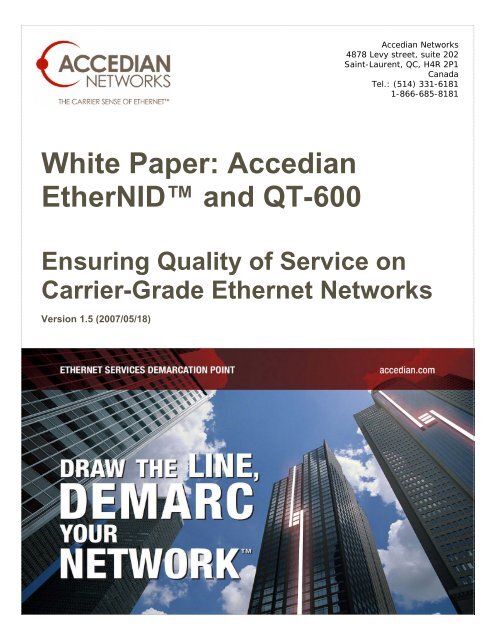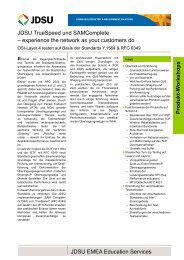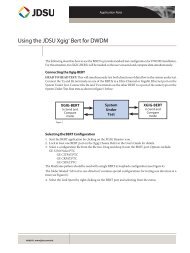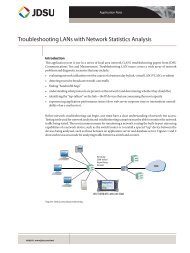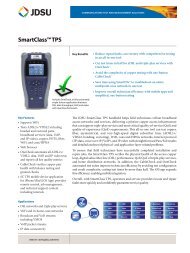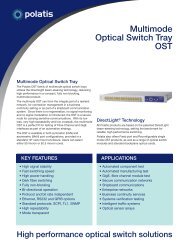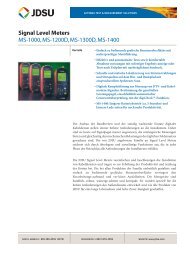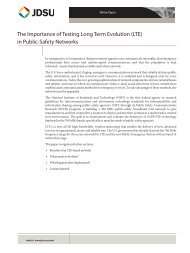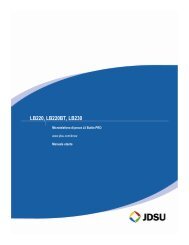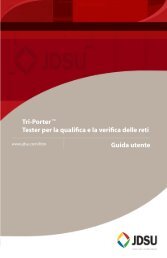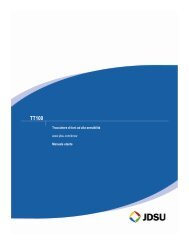White Paper: Accedian EtherNID™ and QT-600 - JDSU
White Paper: Accedian EtherNID™ and QT-600 - JDSU
White Paper: Accedian EtherNID™ and QT-600 - JDSU
You also want an ePaper? Increase the reach of your titles
YUMPU automatically turns print PDFs into web optimized ePapers that Google loves.
<strong>White</strong> <strong>Paper</strong>: <strong>Accedian</strong><br />
EtherNID <strong>and</strong> <strong>QT</strong>-<strong>600</strong><br />
<strong>Accedian</strong> Networks<br />
4878 Levy street, suite 202<br />
Saint-Laurent, QC, H4R 2P1<br />
Canada<br />
Tel.: (514) 331-6181<br />
1-866-685-8181<br />
Ensuring Quality of Service on<br />
Carrier-Grade Ethernet Networks<br />
Version 1.5 (2007/05/18)
<strong>White</strong> paper: <strong>Accedian</strong> EtherNID <strong>and</strong> <strong>JDSU</strong> <strong>QT</strong>-<strong>600</strong><br />
Version 1.5 (2007-05-18) by Damien Ramé, <strong>Accedian</strong> Networks Inc.<br />
<strong>White</strong> <strong>Paper</strong><br />
<strong>Accedian</strong> EtherNID <strong>and</strong> <strong>JDSU</strong> <strong>QT</strong>-<strong>600</strong><br />
Ensuring Quality of Service on Carrier-Grade Ethernet Networks<br />
The growing dem<strong>and</strong> in IP-based services, such as Voice over IP (VoIP) <strong>and</strong><br />
Internet Protocol Television (IPTV), is driving the need for affordable b<strong>and</strong>width<br />
while adhering to ever more stringent Service Level Agreements (SLA) <strong>and</strong><br />
ensuring acceptable end-to-end Quality of Service (QoS).<br />
Carrier-Grade Ethernet Services come up as a very interesting technology to solve<br />
this equation, but operators are facing important challenges when the time comes<br />
to measure QoS <strong>and</strong> ensure SLAs. Traditional Ethernet was originally intended<br />
solely for LAN usage <strong>and</strong> lacks functionality in several aspects such as OAM, link<br />
level performance monitoring, manageability, demarcation, loopbacks <strong>and</strong> fault<br />
isolations.<br />
Despite these shortcomings of traditional Ethernet, Carriers are confronted with an<br />
overwhelming customer dem<strong>and</strong> <strong>and</strong> the need for Carrier-Grade Ethernet access<br />
devices <strong>and</strong> testing equipments is thus increasing rapidly.<br />
Teaming up <strong>JDSU</strong> <strong>QT</strong>-<strong>600</strong> <strong>and</strong> <strong>Accedian</strong> EtherNID<br />
<strong>Accedian</strong> Network’s EtherNID is an ideal companion to the <strong>QT</strong>-<strong>600</strong> <strong>and</strong><br />
NetComplete.<br />
Capable of Wire-Speed Layer 2, Layer 3 <strong>and</strong> Layer 4 loopbacks, the EtherNID<br />
allows the <strong>QT</strong>-<strong>600</strong> to perform point to point tests <strong>and</strong> benchmarks at the Ethernet<br />
Frame (layer 2) level.<br />
`<br />
NetComplete<br />
<strong>JDSU</strong> <strong>QT</strong>-<strong>600</strong><br />
Layer 2 Traffic<br />
In-b<strong>and</strong> Loopback comm<strong>and</strong><br />
frame from <strong>QT</strong>-<strong>600</strong><br />
Loopback<br />
Looped-back<br />
Layer 2 Traffic<br />
<strong>Accedian</strong> Networks<br />
EtherNID TM<br />
The EtherNID will natively detect <strong>and</strong> process the <strong>QT</strong>-<strong>600</strong>’s in-b<strong>and</strong> loopback<br />
enable <strong>and</strong> disable (up/down) comm<strong>and</strong> frames, hence avoiding the need for<br />
additional remote logins <strong>and</strong> connections (console, telnet/ssh or web), remote<br />
operators <strong>and</strong> expensive truck-rolls. The entire testing procedure is automated <strong>and</strong><br />
Page 1
<strong>White</strong> paper: <strong>Accedian</strong> EtherNID <strong>and</strong> <strong>JDSU</strong> <strong>QT</strong>-<strong>600</strong><br />
Version 1.5 (2007-05-18) by Damien Ramé, <strong>Accedian</strong> Networks Inc.<br />
<strong>White</strong> <strong>Paper</strong><br />
<strong>Accedian</strong> EtherNID <strong>and</strong> <strong>JDSU</strong> <strong>QT</strong>-<strong>600</strong><br />
controlled directly through <strong>JDSU</strong>’s <strong>QT</strong>-<strong>600</strong> Ehternet & Triple-Play Probe <strong>and</strong><br />
NetComplete software.<br />
Using its unique Fast-Thru engine, the EtherNID not only provides Wire-Speed<br />
throughput with zero packet loss but also operates without introducing any<br />
significant latency <strong>and</strong> jitter, thus allowing the <strong>QT</strong>-<strong>600</strong> to provide accurate <strong>and</strong><br />
unbiased test results. Furthermore, the EtherNID can be powered directly via<br />
Power over Ethernet (PoE) <strong>and</strong> has redundant power sources in order to be<br />
available in any conditions.<br />
Test everything up to the Last Mile<br />
With current Ethernet solutions, a Service Provider can not test or diagnose the<br />
entire link, or ensure its SLA end-to-end. The Last Mile is invisible to operators’<br />
testing equipments, or will include the Customer’s network.<br />
<strong>Accedian</strong> Networks’ innovative EtherNID creates a clear demarcation point<br />
between the Carrier’s <strong>and</strong> the Customer’s networks <strong>and</strong> in conjunction with the <strong>QT</strong>-<br />
<strong>600</strong> <strong>and</strong> NetComplete software provides visibility all the way to the Customer’s<br />
Premises. This solution allows the operator to effectively isolate the customer’s<br />
network from the test <strong>and</strong> thus eliminate diagnostic errors.<br />
In this scenario, an Access Service Provider would install a <strong>JDSU</strong> <strong>QT</strong>-<strong>600</strong> in a<br />
strategic location in its network <strong>and</strong> place EtherNID products at the end point of<br />
each customer’s link, as a Customer’s Premises Equipment (CPE). Whether the<br />
service is E-Line, E-LAN, E-Tree (Hub & Spoke), Internet connection, the Ethernet<br />
Access Provider will be able to obtain precise measurements up to the Customer’s<br />
Page 2
<strong>White</strong> paper: <strong>Accedian</strong> EtherNID <strong>and</strong> <strong>JDSU</strong> <strong>QT</strong>-<strong>600</strong><br />
Version 1.5 (2007-05-18) by Damien Ramé, <strong>Accedian</strong> Networks Inc.<br />
<strong>White</strong> <strong>Paper</strong><br />
<strong>Accedian</strong> EtherNID <strong>and</strong> <strong>JDSU</strong> <strong>QT</strong>-<strong>600</strong><br />
Premises using the <strong>QT</strong>-<strong>600</strong> <strong>and</strong> NetComplete, <strong>and</strong> thus guarantee <strong>and</strong> troubleshoot<br />
the customer’s Quality of Service appropriately.<br />
In addition to these clear benefits, <strong>Accedian</strong> Networks’ EtherNID line of products<br />
allows the Service Provider to use the device as an Intelligent Media Converter<br />
(10/100/1000 Mbps, fiber or copper) using the EtherNID OE <strong>and</strong> GE’s Small<br />
Form-factor Pluggable transceiver (SFP) receptacles.<br />
Diagnose <strong>and</strong> pinpoint Multi-Carrier problems easily <strong>and</strong> precisely<br />
In many cases, an end-to-end customer link spans across multiple Carriers <strong>and</strong><br />
only the most limited diagnostic tools (none in layer 2, traceroute in layer 3) can be<br />
used to test <strong>and</strong> resolve connectivity problems.<br />
By allowing a better sectionalization of the end-to-end link, <strong>Accedian</strong>’s EtherNID<br />
can help operators diagnose Multi-Carrier situations when experiencing issues, <strong>and</strong><br />
eliminate needless finger pointing between Carriers.<br />
In regards to his customers, an operator is responsible for the entire end-to-end<br />
SLA, <strong>and</strong> not only has to be able to measure the entire performance, but also has<br />
to be able to pinpoint the exact location of potential problems in order to resolve<br />
these.<br />
By placing an EtherNID between each Carrier Network, the <strong>QT</strong>-<strong>600</strong> will be able to<br />
run tests using in-b<strong>and</strong> loopback comm<strong>and</strong> frames for each section.<br />
In the scenario above, assuming there is a performance issue with the Customer’s<br />
connection, the operator would then connect to the <strong>QT</strong>-<strong>600</strong> <strong>and</strong> use the<br />
NetComplete software to run a loopback test between the <strong>QT</strong>-<strong>600</strong> <strong>and</strong> the first<br />
EtherNID in order to validate the first Carrier A Network’s quality. He would then<br />
proceed to run a similar test between the <strong>QT</strong>-<strong>600</strong> <strong>and</strong> the second EtherNID,<br />
Page 3
<strong>White</strong> paper: <strong>Accedian</strong> EtherNID <strong>and</strong> <strong>JDSU</strong> <strong>QT</strong>-<strong>600</strong><br />
Version 1.5 (2007-05-18) by Damien Ramé, <strong>Accedian</strong> Networks Inc.<br />
<strong>White</strong> <strong>Paper</strong><br />
<strong>Accedian</strong> EtherNID <strong>and</strong> <strong>JDSU</strong> <strong>QT</strong>-<strong>600</strong><br />
encompassing both Carrier A <strong>and</strong> Carrier B Network’s sections. Finally, a third test<br />
comprised of all three sections would provide measurements for the entire link, all<br />
the way up to the Customer’s Premises, with the assistance of a clear demarcation<br />
point provided by the EtherNID, thus eliminating any potential problems in the<br />
Customer’s own network in the process.<br />
In cases where the problem occurs on two (or more) networks, a more advanced<br />
diagnostic test may be used. In the example above, the second <strong>and</strong> third section<br />
tests may return measurements indicating a problem with both Carrier B’s network<br />
<strong>and</strong> Carrier A’s (close to the customer) network, but the operator at the <strong>QT</strong>-<strong>600</strong><br />
may be unable to pinpoint the exact problem.<br />
Two <strong>QT</strong>-<strong>600</strong>’s may then be used to run tests in bi-directional incremental sections,<br />
as depicted in the figure above, <strong>and</strong> allow the operator to easily pinpoint the exact<br />
source of the service failure.<br />
Improve your Ethernet network’s performance <strong>and</strong> fault detection using<br />
<strong>Accedian</strong> EtherNID<br />
A <strong>QT</strong>-<strong>600</strong> <strong>and</strong> a number of EtherNID products is also an ideal solution to<br />
diagnostic problems inside a Carrier’s network. Because of its affordable pricepoint<br />
<strong>and</strong> ultra-low latency <strong>and</strong> jitter, EtherNID products may be deployed at<br />
large within the Carrier’s network <strong>and</strong> allow operators to easily <strong>and</strong> automatically<br />
use sub-sections of the network for testing <strong>and</strong> diagnostics.<br />
Page 4
<strong>White</strong> paper: <strong>Accedian</strong> EtherNID <strong>and</strong> <strong>JDSU</strong> <strong>QT</strong>-<strong>600</strong><br />
Version 1.5 (2007-05-18) by Damien Ramé, <strong>Accedian</strong> Networks Inc.<br />
<strong>White</strong> <strong>Paper</strong><br />
<strong>Accedian</strong> EtherNID <strong>and</strong> <strong>JDSU</strong> <strong>QT</strong>-<strong>600</strong><br />
With a strategically located <strong>QT</strong>-<strong>600</strong>, the operator will then be able to test multiple<br />
sections or paths in his own network, in order to ensure the network’s performance<br />
is up to the SLA, pinpoint exact locations of equipment failures, <strong>and</strong> even run endto-end<br />
tests all the way up to the Customer’s Premises.<br />
Conclusion<br />
In the growing environment of Carrier-Grade Ethernet Networks <strong>and</strong> IP-services<br />
such as VoIP <strong>and</strong> IPTV, ensuring Service Level Agreements <strong>and</strong> assuring the best<br />
Quality of Service possible evolved from being a competitive advantage to an<br />
absolute necessity. In order to achieve the expected performance, operators need<br />
enhanced test equipments <strong>and</strong> capabilities, as well as devices used to actually<br />
measure performance of their own network as well as end-to-end links while<br />
disregarding the customer’s own network. The combination of <strong>JDSU</strong>’s <strong>QT</strong>-<strong>600</strong> <strong>and</strong><br />
multiple <strong>Accedian</strong> Networks’ EtherNID products forms an ideal team to address all<br />
these needs.<br />
Page 5


